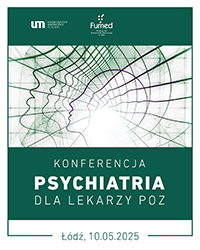Clinical and microbiological evaluation in patients with Fournier’s gangrene
Agnieszka Grabińska1, Adam Daniel Durma2, Łukasz Michalczyk3, Anna Celina Durma4, Anna Grabińska5, Tomasz Syryło1, Tomasz Ząbkowski1
 Affiliation and address for correspondence
Affiliation and address for correspondenceIntroduction: Necrotising fasciitis (Fournier’s gangrene) is a bacterial inflammation of the subcutaneous tissues and skin, involving the urogenital area. The treatment is complex, with a high risk of systemic infection. A key aspect of treatment is antibiotic therapy. Materials and methods: The analysis involved 30 hospitalised patients with Fournier’s gangrene. An attempt was made to determine the relationship between laboratory parameters, types of pathogens, patterns of antibiotic susceptibility/ resistance, and treatment outcomes. Results: The average value of Fournier’s Gangrene Severity Index (FGSI) was 4.37 ± 2.87. In the study group, a total of 18 (60%) patients had an infection caused by a single bacterial strain, while 12 (40%) had infections caused by multiple strains. The most commonly identified bacteria was Escherichia coli (53.33%) – 50% of monocultural infections and 58.33% of polyculture infections. The majority of bacteria were sensitive to piperacillin–tazobactam – 22 (73.33%) patients, clindamycin – 20 (66.66%) patients, and metronidazole – 18 (60%) patients. The highest percentage of antibiotic resistance was observed for cefuroxime – 19 (63.33%) patients, ciprofloxacin – 19 (63.33%) patients, and ceftriaxone – 17 (56.66%) patients. The average hospitalisation length was 30.03 ± 23.01 days. The overall mortality rate was 13.33% (n = 4). No correlation was found between the type of pathogen, hospitalisation length or mortality. No differences were observed in the results of laboratory parameters, FGSI, or length of hospitalisation in the analysed subgroups. Conclusions: Effective treatment of Fournier’s gangrene requires performing a wound swab culture as quickly as possible and implementing a targeted antibiotic therapy. There is no single laboratory parameter that can predict treatment outcomes and patient prognosis. There are no differences in the clinical course and prognosis between multibacterial and monobacterial infections.











